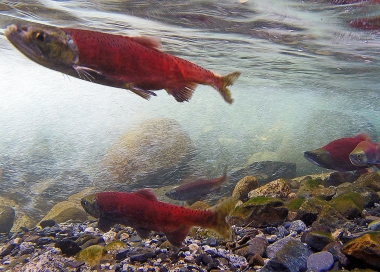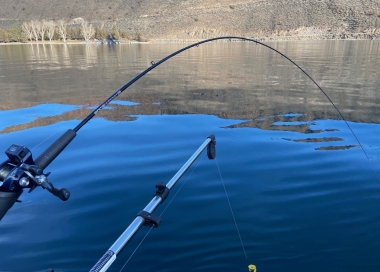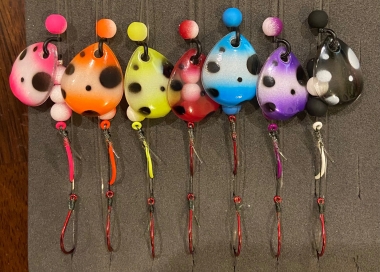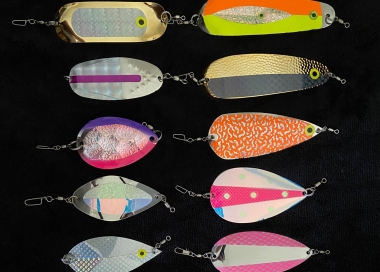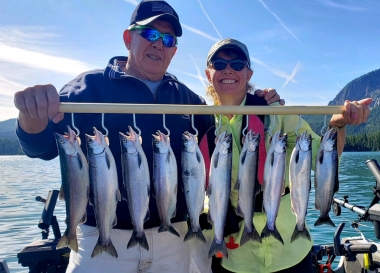
Kokanee fishing in Oregon
Kokanee are fun to catch, delicious to eat, and found in lakes and reservoirs throughout the state.

What is a kokanee?
A kokanee is a landlocked, freshwater sockeye salmon. Unlike its relative the sockeye, which travels to and from the ocean, kokanee live their entire lives in fresh water. While most kokanee average between 10 and 15 inches, they can get larger – the state record 9 lb 10 oz kokanee was caught in Wallowa Lake in 2010.
Kokanee filter feed on tiny plankton and zooplankton in the lakes and reservoirs. In the fall, mature fish will spawn in adjacent streams or on gravel shorelines. Like all Pacific salmon, kokanee die after spawning.
Kokanee have delicate flesh and are known as excellent table fair. Prepare them the same way you would salmon or trout. You can help preserve their deliciousness by bleeding them and getting them on ice as quickly as possible in the boat.
Tom Schnell and Greg Grenbemer, ODFW hatchery manager, are avid kokanee anglers, and have collaborated to share their insights into kokanee fishing in Oregon.
9 tips for catching kokanee
It’s better with a boat.
Kokanee tend to be an open water fish, and most anglers target them from a boat or flotation device such as a kayak or float tube. Very few are caught from the bank. Kokanee can be found anywhere from close to the surface to hundreds of feet down, in deeper lakes. Having a depth/fish finder, down riggers and a long-handled net are all very helpful.
There’s jigging and there’s trolling.
There are two primary ways to catch kokanee, jigging and trolling. When jigging, find schools on your fish finder and jig at the same depth as the fish. You also can cast a jig at any fish you see jumping at the water surface.
There are three primary trolling methods: long lining, dropper rod and using down riggers.
- Long lining uses a heavier attractor, usually a dodger, and letting out 100-150 feet of line with no weight. This will get you down as deep as 10-12 feet.
- Dropper rod fishing uses a weight in front of your attractor, although some anglers still use lead core line instead. Most use 1-3 oz. of weight. Anything over 6 oz. and you’ll be better off using a down rigger. This line will get your lure and bait as deep as 40 feet, depending on the amount of lead, the length of the line and the trolling speed.
- When you need to go deeper than 30-40 feet, down riggers are an invaluable tool.
A downrigger is essentially a winch on the side of the boat that helps you get your lure deeper. The winch uses a light cable or heavy line to help lift or lower 6 to 10 pounds of weight – and with it your lure – to the depth you want to fish.
Color matters, some.
Preferred colors for kokanee are pink, orange and chartreuse. Red, blue, purple, white, black or any combination of these colors can produce strikes, so don’t be afraid to experiment with various colors.
Troll slowly.
When trolling for kokanee go slower than you would for their salmon cousins. Most people will troll between 0.8-1.6 mph. Adding some “S” turns as you troll can often incite a bite.
Remember the bait.
One must in kokanee fishing is tipping your lure’s hooks with white shoepeg corn, shrimp or maggots. You can add various scents and colors to the corn such as tuna oil, garlic, anise and variety of other scents. Adding pink and orange dye also can help change it up some, too.
Select light gear.
Rods and reels should be on the ultra-light side. There are many kokanee specific rods on the market -- most are in the 7- to 8-foot range.
- Fishing with a down rigger calls for a rod that’s very flexible and “loads up” under pressure.
- A good dropper rod will have more back bone for trolling with extra weight.
A limber rod will let you feel the fight of the fish and improve your hook-to-land ratio. A good line-counter reel will make it easier to know exactly how much line you have out.
Think salmon lures but smaller.
Popular lures include inline trolls and dodgers, which are becoming increasingly popular due to their low water resistance. Spinners, spoons, hoochies and other types of salmon lures work for kokanee, just in much smaller sizes since most kokanee don’t exceed 15 inches. There also are a lot of kokanee specific lures and dodgers on the market.
Go with a stout leader.
Kokanee are not leader shy, so 10-15 lb test monofilament leader is standard. A good rule of thumb for leaders between the dodger and lure is 2 ½ times the dodger length – usually 9 to 24 inches long. Use shorter leaders for lures that don’t have their own action, like hoochies, and longer leaders for spinners and spoons.
Kokanee are acrobatic fighters with very soft mouths, so a slow steady retrieve with light gear will help you land more fish. Be patient, lost fish are part of the kokanee game.
Where and when to find kokanee.
Kokanee can be fished year-round, although most anglers target them from April through August. Check the ODF&W fishing regulations for seasons, limits and any additional restrictions on the lake you plan to fish.
Kokanee lakes in Oregon
Northwest Zone
- Triangle Lake
Willamette Zone
- Big Cliff Reservoir
- Detroit Reservoir
- Foster Reservoir
- Green Peter Reservoir
- Timothy Lake
- Waldo Lake
Central Zone
- Crane Prairie Reservoir
- Crescent Lake
- East Lake
- Elk Lake
- Haystack Reservoir
- Lake Billy Chinook Reservoir
- Lost Lake
- Odell Lake
- Paulina Lake
- Simtustus Reservoir
- Suttle Lake
- Wickiup Reservoir
Southeast Zone
- Fourmile Lake
- Lake of the Woods
- Miller Lake
Northeast Zone
- Olive Lake
- Wallowa Lake
Tom Schnell is a decades-long kokanee angler from Central Oregon. He and his wife fish kokanee as a team -- she catches them and he nets them. Tom also is a board member of Kokanee Power Oregon. Greg Grenbemer is an avid kokanee angler and manager of ODFW's Marion Forks Hatchery near Idanha.
Header photo courtesy of Tom Schnell.

